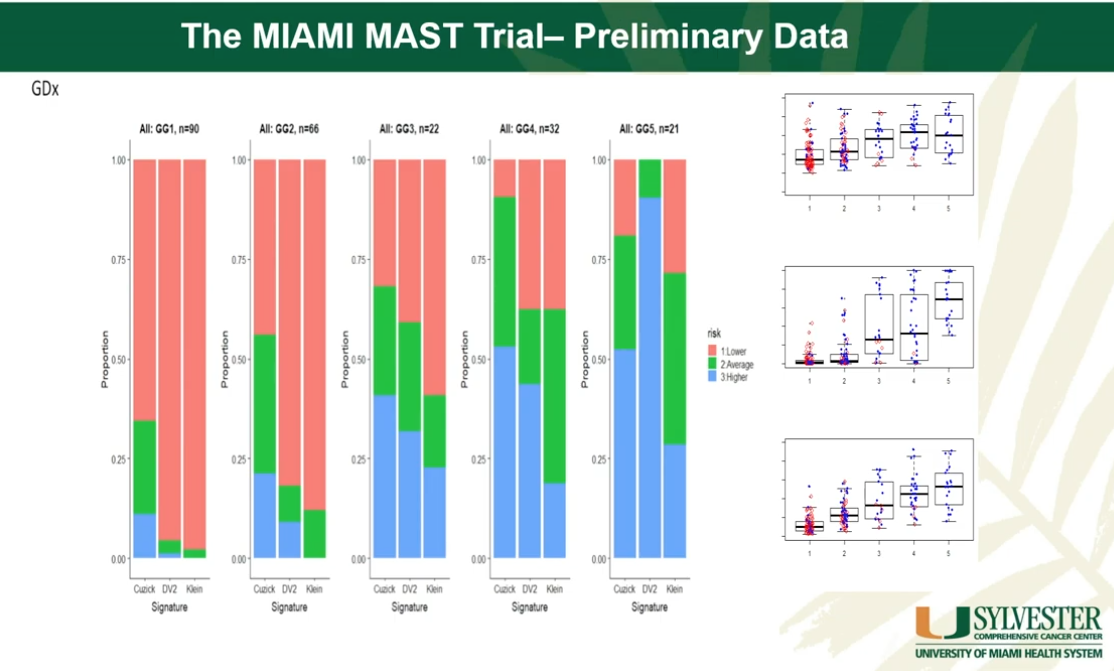Sanoj Punnen, MD, MAS, presented “Radiogenomics in Active Surveillance: How Can We Integrate mpMRI and Genomics to Monitor Prostate Cancer” during the 4th Global Summit on Precision Diagnosis and Treatment of Prostate Cancer on October 3, 2019 in Boston, Massachusetts.
How to cite: Punnen, Sanoj. “Radiogenomics in Active Surveillance: How Can We Integrate mpMRI and Genomics to Monitor Prostate Cancer” October 3, 2019. Accessed Jul 2025. https://grandroundsinurology.com/radiogenomics-in-active-surveillance-how-can-we-integrate-mpmri-and-genomics-to-monitor-prostate-cancer/
Radiogenomics in Active Surveillance: How Can We Integrate mpMRI and Genomics to Monitor Prostate Cancer – Summary:
Sanoj Punnen, MD, MAS, discusses the limitations of multiparametric MRI (mpMRI) and genomic biomarkers in selecting men with intermediate or high-risk prostate cancer for active surveillance. He suggests that combining mpMRI and genomics may allow for more accurate risk-stratification, focusing on preliminary data from the Miami MAST trial.
Abstract:
Active surveillance is a safe alternative to immediate treatment in well-selected prostate cancer patients that doesn’t compromise cancer-specific or overall survival. However, intermediate and high-risk patients have an increased mortality rate and risk of developing metastases on active surveillance. Genomic markers and mpMRI could potentially improve patient selection for surveillance. Unfortunately, these tools have severe limitations.
Because of its negative predictive value, mpMRI can have untrustworthy results. However, a recently-developed habitat risk scoring system could potentially mitigate this issue. Genomic biomarkers can stratify patients based on genomic diversity who would otherwise be classified in the same risk group based on pathology alone. Still, genomic heterogeneity, both between different cores from a prostate and results from different assays, remains a limitation of biomarkers. Neither of these tools on their own can safely identify intermediate-risk prostate cancer patients to go on surveillance.
To address this unmet need, researchers on the Miami MAST Trial have been evaluating which constellation of molecular, imaging, and genomic markers add to clinical information for predicting progression on active surveillance. Unsurprisingly, preliminary data observes that clinical risk level changes significantly depending on the core taken and test used.
The translational goals of this trial include gaining a detailed understanding of how different genomic and molecular tests perform, and how to effectively integrate MRI and genomic information.
About The 4th Global Summit on Precision Diagnosis and Treatment of Prostate Cancer:
The Global Summit on Precision Diagnosis and Treatment of Prostate Cancer is a multi-day, multi-disciplinary forum designated to informing health care stakeholders about topics including in-vitro fluid and tissue-based molecular diagnostics, novel observation strategies such as active surveillance, and novel therapeutic interventions. Along with this forum’s efforts to form a consensus on the future of prostate diagnostics and precision care, it aims to create an educational and research strategy for its realization. Dr. Punnen presented this lecture during the 4th iteration of this Summit in 2019.
ABOUT THE AUTHOR
Sanoj Punnen, MD, MAS, completed his medical school at Queen’s University and urology residency at the University of Toronto in Canada. He then completed a uro-oncology fellowship and Master’s in Clinical Research at the University of California, San Francisco. He is board-certified in both urology and uro-oncology. His primary research interest is in localized prostate cancer. Specifically, his work has evaluated imaging, molecular, and genomic markers that play a role in prostate cancer diagnosis and prognosis. He is also involved in outcomes and health service research on trends in the incidence and management of prostate cancer.

